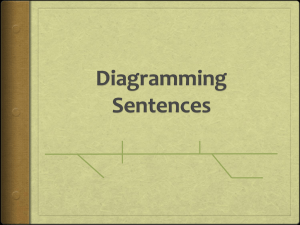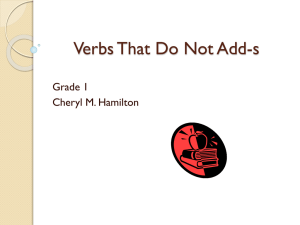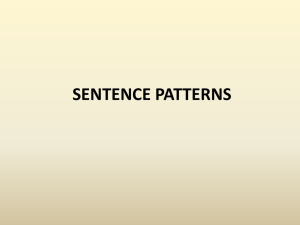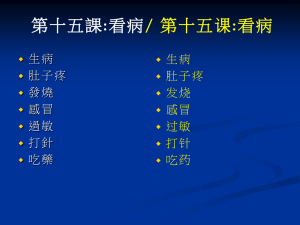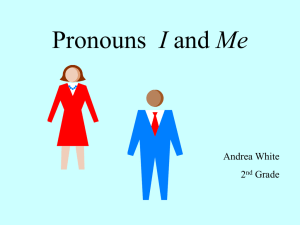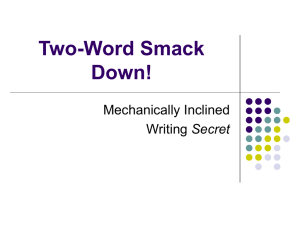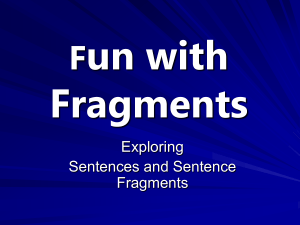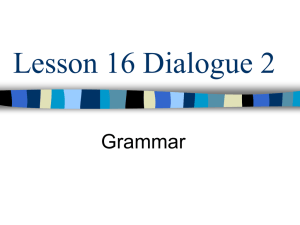SENTENCE PATTERNS
advertisement
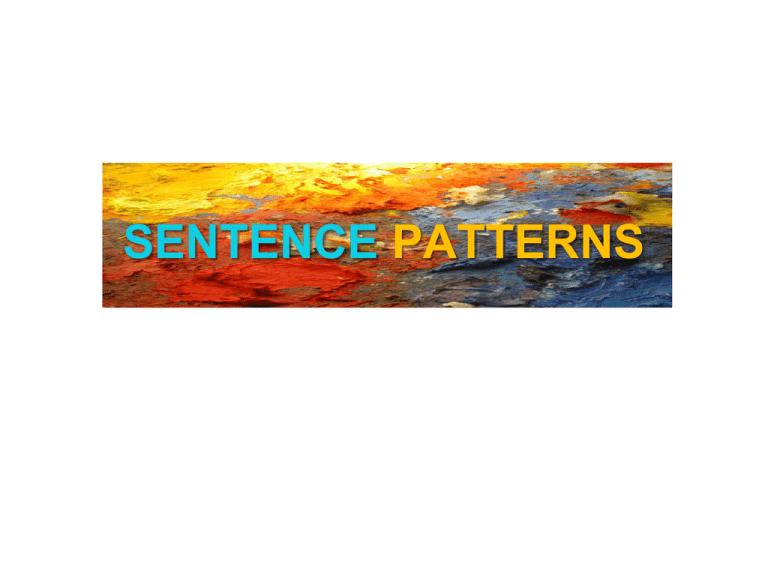
SENTENCE PATTERNS Sentence Parts Subject – verb – direct object or subject complement -- modifiers 1A genome is all the genetic material in the chromosomes of an organism. 2 The human genome includes about three billion base pairs that make up human DNA. 3 The Human Genome Project, completed in 2003, was a 13-year, international effort to identify the 20,000-25,000 human genes and make them accessible for further biological study. 4 This research has catalyzed biotechnology. Sentence Patterns Subject – verb – direct object or subject complement 1. The Dow Jones Industrial Average fell by 53 points. S-V 2. The students worked the algebra problems. S-V-DO 3. A virus is a pathogen. S-V-SCN OR All members are present. S-V-SCA 4. Jane’s boss offered her a raise. S-V-IO-DO 5. I consider you my best friend. S-V-DO-DOCA OR The women found the candidate’s language offensive. S-V-DO-DOCA 1. S + V The subject is followed by an intransitive verb , which takes no direct object. (Note: In the diagrams, “NP” = noun phrase.) Even if the verb is followed by a prepositional phrase, the verb is still intransitive if it does not take a direct object. Ex:The children are sleeping in the next room. Who is calling at this hour? 2. S+ V + D O The subject is followed by a transitive verb, which has a direct object. Note: There are now 2 nouns in the sentence: NP1= subject; NP2= direct object. My brother is taking his wife on a cruise. 3a. S + LV + SC A linking verb is followed by a subject complement (adjective) that describes the subject (SCA). The SCA may be a prepositional phrase. 3b. S + LV + SCN A linking verb is followed by a subject complement (noun) that renames the subject (SCN). Note: The second noun, the subject complement, is still designated as NP1 because it refers to the same thing (Mr. James = teacher). 3c. S + LV + ADV(Time/Place) A linking verb may also be followed by an adverb indicating where or when. • The adverbial indicating where or when may be a prepositional phrase. More Linking Verbs • The linking verb may be a word similar to “be,” such as “seem,” “appear,” “become,” or “looks.” • Or, it may be a verb relating to the senses. Grandma’s house always smelled like moth balls. NP1 subject LV ADJ subjective complement The air feels wintry today. NP1 LV subject ADJ subjective complement 4. S + V + IO + DO A transitive verb may be followed by an indirect object and then a direct object. A test for an indirect object is to put the DO first and the IO after it with “to” or “for.” Ex. Smithers gave a raise to the employees. Note: There are now 3 different nouns in the sentence: NP1, NP2, and NP3. 5a. S + V + DO + DOCA The transitive verb is followed by a direct object, and the direct object is followed by an object complement (adjective or noun). The DOCA describes the direct object. 5b. S + V + DO + DOCN The DOCN renames the direct object. Note: Just like the SCN, the DOCN refers to the same thing: Jacobsen=friend.
